Categories
- b2b, lead nurturing, inbound marketing, lead generation, sales, email marketing
- blogging, content, hubspot, inbound, marketing, podcasting, strategy
- book publishing, small business, small business marketing, branding, lead generation, writing a book, webinar marketing, webinar
- business, content, feature, inbound, management, marketing, podcast, positioning, product, small, video, videos
- business blogging, lead generation, inbound marketing, marketing podcast, content marketing, facebook marketing, facebook ads, i
- chat, chatbots, hubspot, drift, ai, lead generation, lead nurturing, digital marketing, inbound marketing, inbound, automation
- general
- hubspot, crm, customer relationship management, lead management, sales, sales management, crm software, sales software, sales en
- hubspot, email marketing, inbound marketing, small business, sales tips, email
- hubspot, inbound marketing, abm, account-based marketing, enterprise sales, sales, lead management
- hubspot, inbound marketing, sales automation, sales tips, sales enablement, research, sales software
- hubspot, lead management, sales, crm, inbound sales, sales automation, increase sales, sales enablement, marketing, inbound mark
- hubspot, marketing, inbound marketing, marketing automation, sales automation, marketing software
- inbound marketing, beyonce, coachella, content, content marketing, marketing, sales, hubspot
- inbound sales, sales, inbound marketing, lead generation, sales training
- lead management, crm, sales, sales automation, sales enablement, sales training, sales management, lead routing, sales tools, sa
- marketing, podcast, marketing podcast, sales, inbound marketing, inbound sales, growth hacking, small business
- marketing, systems, sales, hubspot, inbound, small business, productivity, teamwork
- marketing automation software, hubspot, marketing, sales, support, business automation
- marketing podcast, lead generation, lead nurturing, b2b sales, business podcast, small business, copywriting
- marketing podcast, small business, inbound marketing, lead generation, hubspot, inbound marketing
- marketing podcast, small business marketing, small marketing teams
- marketing podcast, smallmarketing teams, small business, marketing, sales, marketing management, management, persuasion
- marketing software, sales software, crm, hubspot, inbound marketing, business podcast, marketing podcast
- marketing trends, business podcast, podcast, marketing podcast, 2017, video marketing, youtube, content marketing, inbound marke
- prioritizing marketing, email marketing, marketing podcast
- sales, inbound sales, hubspot, lead generation, inbound marketing, marketing, sales reps, sales teams
- seo, inbound, inbound marketing, search engines, search engine marketing, sem, search engine optimization
- small business, marketing, hubspot, productivity, inbound marketing, content marketing, marketing podcasts, marketing conference
- small marketing teams, marketing podcast, small business marketing, small business podcast, inbound marketing, content marketing
- web traffic, marketing podcast, marketing prioritization, content marketing, getting found, inbound marketing
The following experiment shows how using HubSpot’s sales tools correctly can help sales reps redirect 30 hours a month back to selling and building relationships.
These days, the line between jargon and effective business communication is razor thin.
When you are running a fast-paced business, the language you use can bring clarity.
However, words can also add confusion. If you have ever tried explaining your job to a friend or relative who is not in your industry, it quickly becomes apparent that we cram too much meaning into business terminology.
For instance, take the following terms:
“Sales enablement”
“Lead generation”
“CRM”
“Marketing automation”
“Sales tools”
“Lead management”
“Sales efficiency”
If I asked 10 executives in my network to define each term, I would get 10 different answers for each.
In addition to business terms meaning different things to different people, marketers have dulled the meaning of business terms so that one term can cover a broad range of business functions.
When you read the terms above, it’s easy to assume their meaning without ever needing to understand the nuances of each strategy and how to implement them successfully in your organization.
“Of course, I want more lead generation.”
“Of course, my team needs a CRM.”
“Of course, marketing automation is important.”
“Of course, my sales reps would benefit from the right sales tools.”
“Of course, my company needs a lead management process.”
We are all in agreement that busy people demand concise language.
However, this attempt to sum up a business function in a couple of short words leaves the conversation at a surface level without ever getting to the heart of how to use these tools and tactics to grow your business.
Moving The "Sales Tools Conversation" From Theory to Real-Life
I am in the business of making a big impact on companies and their employees.
General use of business terms, such as “We will work on sales enablement,” or “Let’s use our CRM to grow faster,” is not enough.
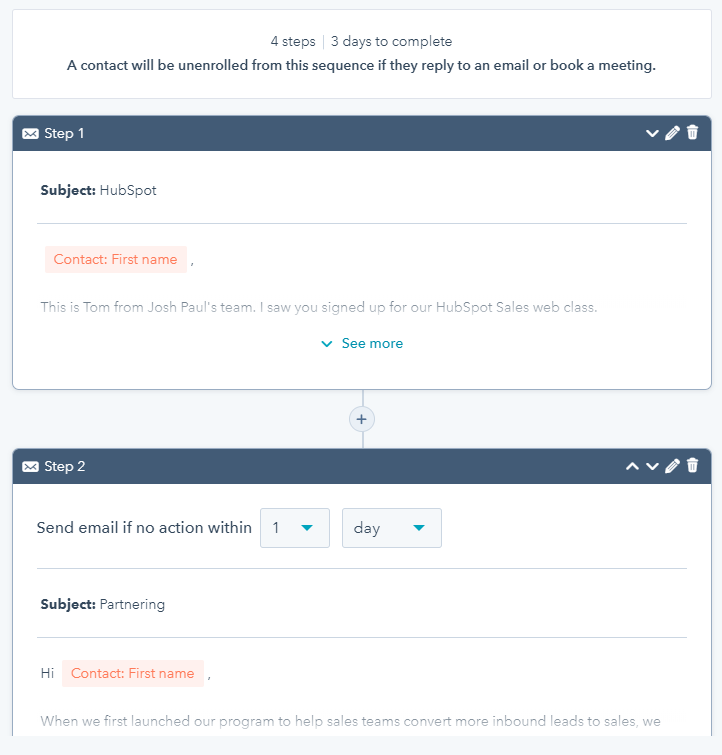 When most people first hear about the HubSpot Sales Tools, they think, “Those sound cool.” This initial reaction is often a major factor in selecting the HubSpot CRM and sales platform.
When most people first hear about the HubSpot Sales Tools, they think, “Those sound cool.” This initial reaction is often a major factor in selecting the HubSpot CRM and sales platform.
However, implementing the HubSpot Sales Tools and getting your sales team to use them is a different story.
I talk to HubSpot customers every week that have access to the HubSpot sales accelerator tools, but are not using them. They are either unaware of how using these tools could benefit their company, or are simply choosing not to use them.
I could share my Hubspot story with these clients until I am blue in the face, but it still would not enact change at some organizations.
So, I took a different approach. I collected real data.
We Ran A HubSpot Sales Tools Experiment
To get this data, my team and I at Small Marketing Teams did an experiment!

We wanted to know how meaningful the time savings was from just TWO of HubSpot Sales Tools: task queues and email templates.
We Started With A Common Sales Rep Scenario
Sales reps have to handle a lot of different types of communication - from prospecting and re-engagement to proposals and follow-ups.
When a new marketing or lead nurturing offer is created, the marketing team will send the content to most of your company’s list.
However, for the leads and opportunities that are engaged with a sales rep, you don’t want marketing interfering with the relationship and messaging that the sales rep is establishing.
For leads they are working, sales reps often distribute new content offers themselves. Having sales reps distribute new white papers, invitations to webinars, and other relevant resources is also a common practice in account-based marketing, where there is a small number of target accounts.
To normalize this scenario for our experiment, we sent five contacts that we are engaged with a personal invitation to an upcoming webinar training we are hosting.
Testing Two Approaches to Sales Productivity
The experiment was simple. We compared the amount of time it took to send five emails to contacts using two different productivity approaches.
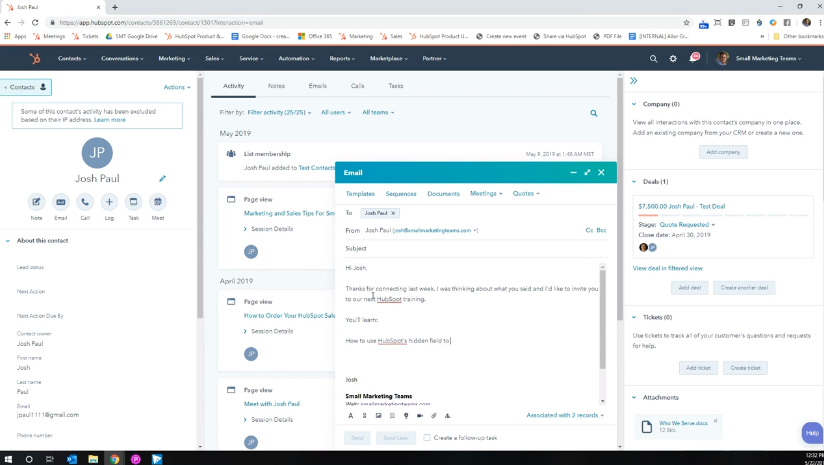
First, I created and sent an email to each of the five contacts inviting them to the webinar. I manually sent them using the HubSpot CRM, but I could have typed these emails in any CRM or email client.
- I located each contact in the CRM. [CLICK]
- I opened a new outgoing email. [CLICK]
- I typed a subject line. [TYPE]
- I wrote the email. [TYPE]
- I inserted the link to the webinar. [CLICK]
- I proofread the email. [READ]
- I clicked send. [CLICK]
I used this approach for each email to all five contacts..
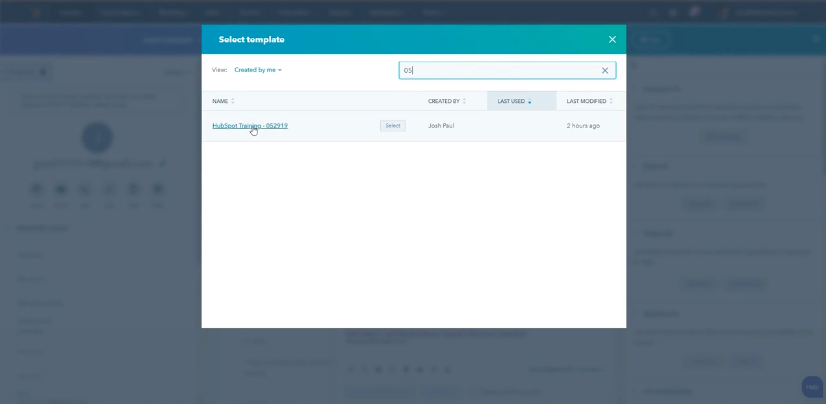
Next, we sent five invitations to the aforementioned webinar using the task queue and email template tool built into HubSpot’s sales platform.
The five contacts were already in a task queue and the email copy was in a HubSpot sales email template. All I did was click start on the task queue before I:
- Opened a new outgoing email. [CLICK]
- Selected the template I want to send. [CLICK]
- Personalized the first sentence of the email. [TYPE]
- Proofread the email. [READ]
- Clicked send. [CLICK]
After I clicked “send” on the email, I merely clicked “next” in the task queue and HubSpot took me to the next contact in the queue.
The Results Of This Sales Efficiency Experiment
Before you read the results of this HubSpot sales automation experiment below, take a minute to make your best guess as to the time it took to:
- Send 5 emails to contacts by writing and sending each email individually (Sales Productivity Approach #1).
- Send 5 emails using HubSpot’s email template and task queue feature (Sales Productivity Approach #2).
Now on the findings of our test…
If you look carefully at the series of steps for each approach outlined above, you’ll see that in addition to more overall steps, the manual approach (#1) included more thinking and typing than the approach that utilized the tools in HubSpot’s sales platform (#2).
More Clicks With Less Thinking and Typing
This experiment highlights the speed in which sales reps can interact with leads, and therefore, bring significantly more leads through the sales process.
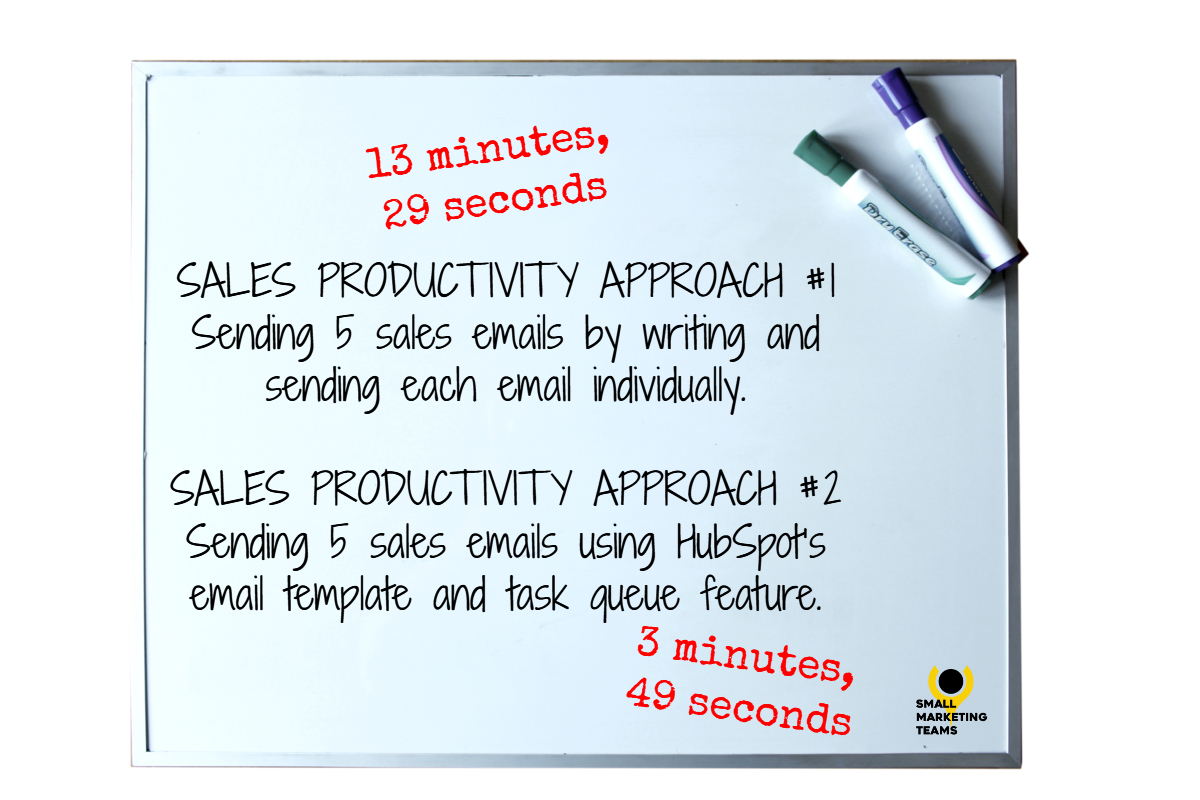
Sales Productivity Approach #1
Total time to send 5 emails: 13 minutes, 29 seconds
Sales Productivity Approach #2
Total time to send 5 emails: 3 minutes, 49 seconds
By using only two tools inside the HubSpot Sales platform, I saved roughly 10 minutes when reaching out to five contacts via email.
The Major Implications for Sales Teams
This “5 email” task was chosen because the activity of emailing leads is very common among salespeople. From these results, you can easily see how choosing the more efficient approach can impact a sales rep's day, week, month, or quarter.
If you are an SDR or a BDR…
This means you are prospecting for new opportunities or qualifying new inbound leads.
- Assume you are working 200 leads at one time.
- Also, assume that you reach out to these 200 contacts once per week.
Leveraging “Sales Productivity Approach #2” would save you 6 hours and 40 minutes hours a week. That gives each sales rep back:
- 30 hours each month.
- 120 hours each quarter.
- 480 hours in a year.
If you are an account executive being fed opportunities by your SDR or BDR...
This means opportunities are turned over to you once they have been qualified.
- Assume you are working 20 opportunities at once with an average of 3 contacts each.
- Also, assume that you reach out to these 60 contacts once per week.
Following “Sales Productivity Approach #2” would give you 2 hours back a week. That comes out to:
- 9 hours each month.
- 27 hours each quarter.
- 108 hours in a year.
If you don’t have an SDR or BDR layer in your sales organization…
This means you cover the sales process from initial connection to close.
- Assume that you are working 60 leads at once.
- Also, assume that you reach out to these 60 contacts twice per week.
Utilizing “Sales Productivity Approach #2” would give you 4 extra hours a week that you can redirect back to selling. That is:
- 18 hours each month.
- 54 hours each quarter.
- 216 hours in a year.
If your situation is slightly different, this model gives you the data and framework to build assumptions specific to your organization.
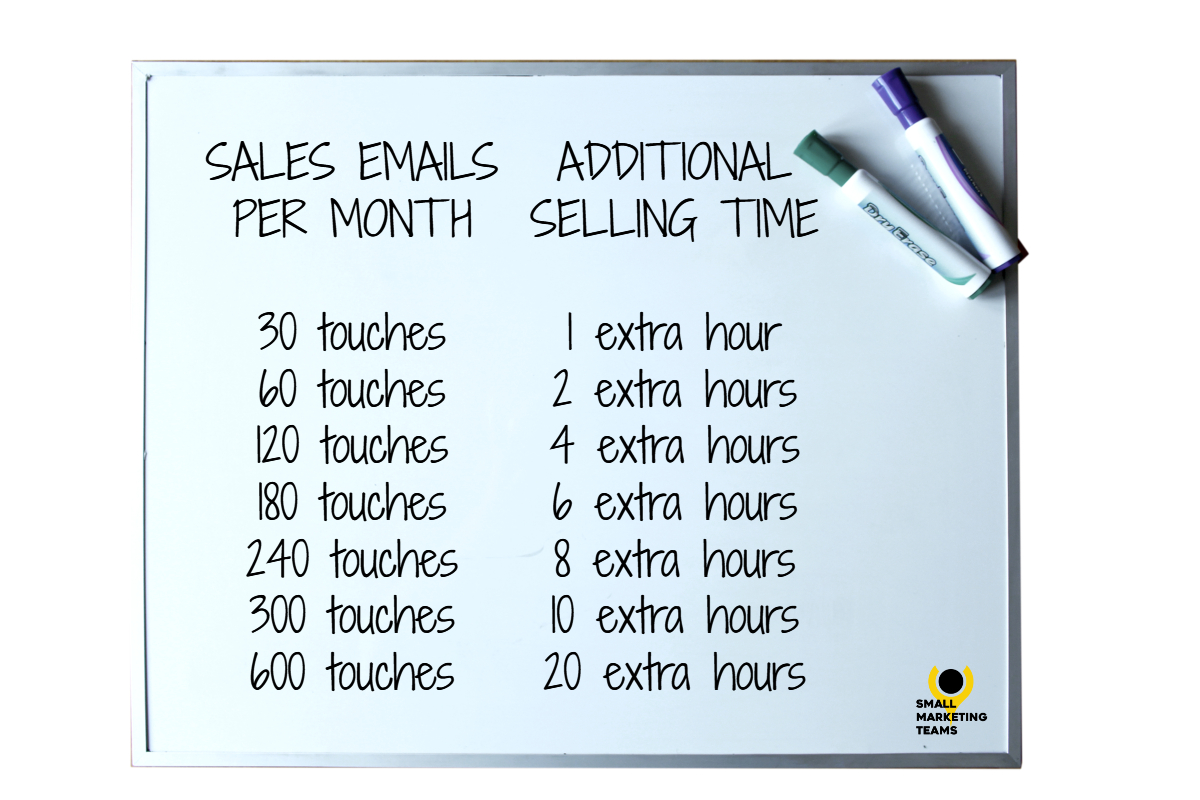
The Takeaway for Executives, Marketers, and Sales Leaders
Your sales team is performing at its current level using their current process, habits, and tools.
According to widely-published sales efficiency research, most sales reps only spend 2-3 hours per day on selling activities. The rest of the time is spent on CRM, data entry, and admin activities.
How would your company’s sales performance change if you could give your sales team an extra hour or two of selling time each day?
If your sales managers can translate those “found” hours into productive selling time and not watercooler hours, it can have a significant impact on your company’s growth.
Ultimately, this time saving translates to 30-50% more sales conversations, demos, proposal calls, or negotiations.
How To Take Steps Toward Improving Sales Efficiency
If you use HubSpot, make sure your team is using the tools inside the sales platform. Also, make sure your lead management process and sales tools are set up correctly.
If you want guidance on how to train your sales team or set up your sales process in HubSpot, ask me about a free consultation today. .
If you don’t currently use HubSpot’s CRM and sales platform, find similar sales productivity tools that work with your CRM. The integration and data won’t be as tight, but you’ll be able to gain some efficiency.
The bottom line is that when you fully adopt processes and tools to create more “selling hours” in the day, you have a competitive advantage.
However, neglecting to arm your sales reps with time-saving tools to help them touch more prospective customers without losing any personalization puts your company at a disadvantage (from which it can take years to recover).
Your Turn…
Do you have any quantifiable data around how HubSpot’s sales tools have made your sales team more productive?
Is your sales team is struggling to get leads on the phone?
This might be one of those situations where technology and easy access to digital data are getting in the way of good old fashioned common sense.
Check this out...
When a new lead gets assigned to one of your sales reps, there are things that sales reps do before trying to connect with the lead?
- They decide when they are going to reach out (hopefully asap)
- They prepare their “connect call” script or outline.
- They open up a new note in their CRM.
- Most importantly, they do research on the lead.
It is important that sales reps try to understand the lead’s situation or the context of their initial conversion so they can make their first touch a relevant interaction.
How Small Marketing Teams Leapfrog Larger Competitors
Since this cursory research only takes a few minutes, it is a major leverage point for small marketing and sales team.
By doing things smarter, your sales reps can close a lot more sales using the same amount of time and effort.
In this episode of the Small Marketing Teams podcast, I discuss how using your lead intelligence differently can result in an increase in revenue.
The first thing you need to know is that not all sales reps use lead intelligence (the data you have about a lead and their interests) the same way.
An AVERAGE sales rep looks at which offer or landing page the lead converted on before calling or emailing them.
A GOOD sales rep analyzes additional digital behavior, including:
- How many web pages they viewed
- When they were last on your website.
- The most recently opened emails
- Data submitted in the landing page form
- Social profiles
Both of these approaches represent the use of quantitative data in building your assumptions about a lead’s problems, priorities, and motivations.
The BEST sales reps take it a step further. They build on quantitative data by adding qualitative elements.
These top performers build a narrative around the journey that the lead look - from the first ad or search engine query to their landing page conversions.
Where do they get this information?
They put themselves in the prospective buyer’s shoes by immersing themselves in the experience that the buyer takes.
They take into account the ad that got the lead’s attention and the language that led them to click on the call to action.
They analyze the copy on the landing page to identify the hook that caused the lead to first opt-in.
If the lead converted on a second or third offer further down the funnel after their first conversion, what was the communication and copy that drove them to take the next step?
Together this information in your CRM enables savvy sales reps to create a fairly accurate narrative that will inform how they connect with, qualify, and build relationships with leads.
Next, let’s explore why this is important.
Continuity Is The Key To Productive Sales Calls
It used to be that prospective buyers did very little digging online before contacting a company. Today, leads do 50-70% of the research on their problem online before reaching out to a sales rep.
That means that they have an understanding of their problem and potential solutions before they ever get connected with your sales team.
Think about the way that you make a purchase. You research online first. By the time that you speak with a salesperson, you are an educated buyer.
Have you ever had an initial conversation with a sales rep where they brought up points and addressed issues that were not relevant to your situation?
Now, think about sales calls you have had where the discussion felt like a continuation of the research and direction you were already heading?
The rapport and momentum of these two calls are completely different. The conversation that is built on a continuation of the experience you have already had closes a lot faster.
Instead of going into sales conversations cold, empower your sales team to look beyond basic sales analytics and be the next step in the messaging and call to action that they lead has already shown appeal to them.
Small Marketing Teams Takeaway
Analytics is great, but knowing each buyer’s journey will give you a competitive advantage.
Just because you have the data in your marketing and sales platforms, does not mean that your sales reps know it is there, know how you use it, and are using it in their sales process.
This takes a clear process, simple actions, and ongoing monitoring of sales tool usage.